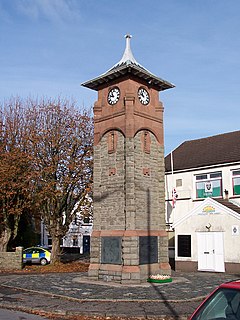Hirwaun
| Hirwaun | |
|---|---|
 Hirwaun War Memorial |
|
| Hirwaun shown within Rhondda Cynon Taf | |
| Population | 4,990 |
| OS grid reference | SN966055 |
| Principal area | |
| Ceremonial county | |
| Country | Wales |
| Sovereign state | United Kingdom |
| Post town | ABERDARE |
| Postcode district | CF44 |
| Dialling code | 01685 |
| Police | South Wales |
| Fire | South Wales |
| Ambulance | Welsh |
| EU Parliament | Wales |
| UK Parliament | |
| Welsh Assembly | |
Hirwaun (Welsh "Long Meadow") is a village at the north end of the Cynon Valley in the County Borough of Rhondda Cynon Taf, South Wales. It is 4 miles (6 km) NW of the town of Aberdare, and comes under the Aberdare post town. At the 2001 census, Hirwaun had a population of 4,851. increasing at the 2011 census to 4,990. The village is on the Heads of the Valleys Road and at the southern edge of the Brecon Beacons National Park.
Hirwaun has an industrial background centring on the Hirwaun Ironworks. After the ironworks closed, coal mining continued, and was a major employer until the second half of the 20th century.
The Crawshay family were powerful, almost all-powerful in the production of steel, and the Hirwaun Ironworks had produced cannons used on HMS Victory. The family owned a large portion of Hirwaun and even used their own currency, the "Hirwaun Guinea", to pay employees, a form of truck system which stopped employees travelling to Cardiff or spending their money outside the controlled economy of the village.
Following the miners' strike, the only deep coal mine left in Wales was Tower Colliery, which closed down, was bought by its workers and reopened.
Anthony Bacon started iron production at Cyfarthfa in 1765. His business partner, Francis Homfray, ran the works during the Napoleonic Wars. The finished product was transported to the port of Cardiff by mules and pack-horses. The works later passed through a succession of owners before being purchased in 1819 by William Crawshay of Cyfarthfa. Crawshay expanded the works, leading to a population influx into the locality. By 1830, nearly 900 men were employed at the Hirwaun works, and in the same year the first railway steam engine seen in the locality began to operate from the works. The ironworks remained in family hands until its closure in 1859. The ironworks' blast furnaces required coke, which spurred an increase in local coal mining.
...
Wikipedia

